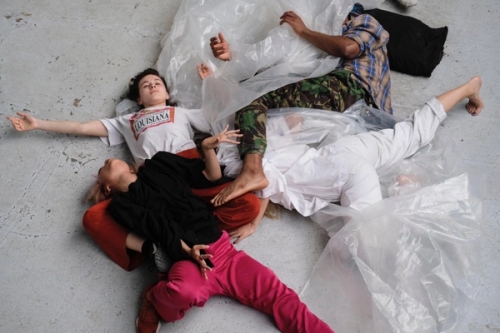Body Wisdom
How dance therapy provides space for our bodies to speak, and us to listen.
- Words By: Shauna Reiman
- Interview With: Ekin Bernay
- First Photo by: Camilla Greenwell

Ekin Bernay believes that where words fail, bodies talk. The performance artist and Dance Movement Psychotherapist living in London has spent 25 years listening to hers, and now works to bring DMP to a wider audience. We talked with Ekin about Dance Movement Therapy, utilizing creativity in understanding self, and the intersection of body and mind.
“...our dances have so many layers to them no matter how gestural, or how repetitive, there is always some information about where we are at in that point in time.”
Can you give us the basic summary of what Dance Movement Psychotherapy is?
Dance Movement Psychotherapy (DMP) utilizes body movement and dance to work towards integrating emotional, physical, social, spiritual and cognitive aspects of self. DMP can be applied to individual and group settings. DMP practitioners can have different approaches to their practice. Some are influenced by Gestalt, some humanistic, some work psychodynamically and so on. While choosing your therapist it is important to understand their approach and see what relates to you most. We believe in the body movements expressive qualities and work with the body, most traditionally through a period of time and re-occuring sessions.
What type of people could benefit the most from DMP?
Anyone who needs to work on themselves can benefit from DMP. It is a highly adaptable method. I have been working with children with Autism, refugee children, adult mental health and now I am in a mainstream primary school. I have also had a Dance Therapist myself and grown so much from my experience with them. Body and movement are ever changing and continuously expressing, so is our internal world. There is so much to discover.

“Recognizing body movement as an implicit and expressive instrument of communication and expression” - ADMP
How does DMP unify people and form a community?
DMP does not always aim at creating a community. However that can happen naturally through shared experiences. The group sessions could allow us to have a sense of belonging. They can also help us build stronger bonds.
How is dance movement psychotherapy tied to art therapy?
They are all under the same umbrella of therapies. Music, drama, play and dance each have their own tools but serve a unified purpose. Utilizing creativity as a method for understanding self. For example in some of my sessions there is no movement but I might be drawing with children.
“We must learn to listen to our bodies.”

In what ways do you feel movement expresses feeling and emotion differently than say verbal communication between a therapist and their client?
First of all some of the people I work with have been non-verbal. In this case all we can depend on is the movement and the body. I also believe that our dances have so many layers to them no matter how gestural, or how repetitive there is always some information about where we are at in that point in time. Certain things we have not yet found the words for show up in movement or present themselves as body postures, tensions or even as injuries. I believe in body wisdom. We must learn to listen to our bodies.
What does dance therapy do for you personally outside of teaching?
Dance therapy creates the perfect circle of my sharing and taking in this world. It is where I share some of the love and knowledge I have cultivated. It helps me stay grounded and reminds me that there are other centers within the universe than my own story.

“there are other centers within the universe than my own story.”
On your instagram we can see you like to play with different materials like fabric, plastic sheets, stockings, etc. Can you give us an idea of your thought process behind mixing materials with movement?
Sometimes the material calls me. I develop an interest in the material and want to see where we can take each other. The material gives me itself and I give myself to it. Within this conversation some information is revealed to me. The process is about learning to be with the material and staying with the material, and myself. These materials also allow me to have an external eye to the process. I can observe myself better within this relationship. It expands the symbolism in my movement world.
You can find out more information on Ekin Bernay and her practice on her instagram: @ekinbernay
- Words By: Shauna Reiman
- Learn More: Ekin Bernay
- Photos by: Camilla Greenwell, Georgia Palmer, and Eda Sancakdar